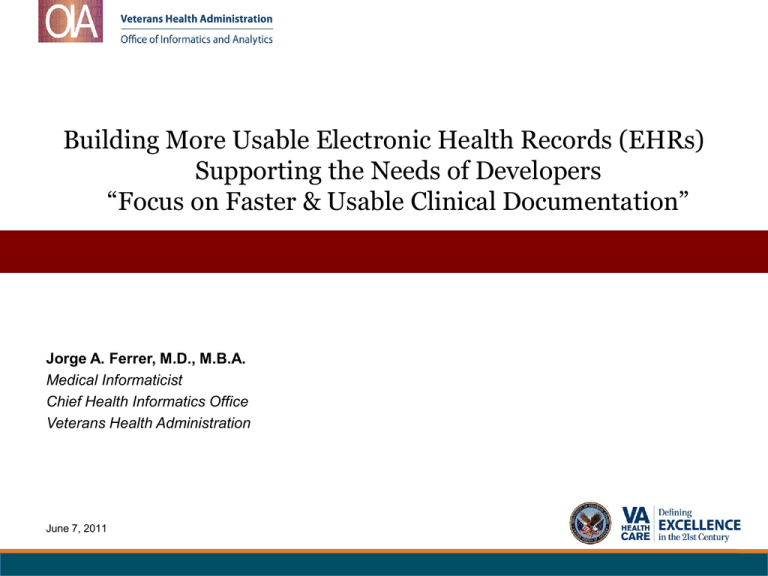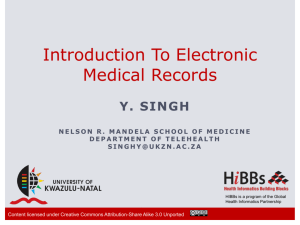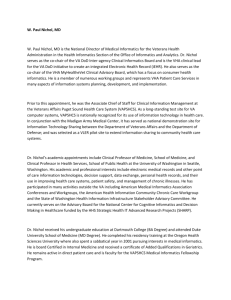Building More Usable Electronic Health Records (EHRs) Supporting
advertisement

Building More Usable Electronic Health Records (EHRs) Supporting the Needs of Developers “Focus on Faster & Usable Clinical Documentation” Jorge A. Ferrer, M.D., M.B.A. Medical Informaticist Chief Health Informatics Office Veterans Health Administration June 7, 2011 Outline Usability references Usability framework of future Electronic Health Records (EHR) Recommendations from literature 2 VHA Office of Informatics and Analytics Electronic Health Record (EHR) References Study: Physician Perceptions of Two Electronic Medical Records (EMRs): VistA* (VA) and GE Centricity Lisa Grabenbauer, University of Nebraska Medical Center (2009) Research Objective: Examine physicians’ perspectives on the objective benefits and limitations of current EMR Conclusions: Current EMR frustrates physician collection of data to improve patient care with cumbersome interfaces and processes Recommendations: EMR must provide seamless and flexible interfaces across system boundaries, for data input as well as data retrieval EMR should facilitate patient and team interactions, not inhibit them *Veterans Health Information Systems and Technology Architecture 3 VHA Office of Informatics and Analytics Knowledge Engineering Group A Qualitative Study of the Electronic Medical Record Lisa Grabenbauer, M.S., Anne Skinner, B.S., John R. Windle M.D. University of Nebraska Medical Center, Omaha, NE Introduction Research Objectives •Explore the sources of resistance to EMR adoption by the physician community •Examine physicians’ perspective on the benefits and limitations of current Electronic Medical Records (EMR) Research Context •Compare environments and culture between •Veteran’s Administration Medical Center (VAMC) paperless system (VistA and CPRS) •The Nebraska Medical Center’s (TNMC) GE Centricity Enterprise system Findings Theme Discussion Benefit •Availability of patient data both spatially and temporally •VA system more comprehensive •University system better organized Workflow •Templated notes save time and improve documentation Study Design •Grounded theory •Small group semistructured interviews •19 participants practicing at both institutions, including residents, house staff and academic physicians •Open-ended questions about EMR interaction •Conducted in November and December 2008 Communication Outcomes and Research •Groups audio-recorded and transcribed •Data elements coded using NVivo v8.0 software •Iterative identification of emergent themes •Themes revised until consensus achieved •Triangulation with existing research Education and Learning •Ability to share patient-centric information •Other providers •Patients •VA system is comprehensive and can link across the country Cost •Time consuming retrieval of select patient information •VA system difficult to search with significant redundancy •University system less comprehensive , requires disconnected data sources Perceived Usefulness Quality of Information Impact on Patient Care •Availability at point of care Structured Data Supports Outcomes and Research Education and Learning •Information input and retrieval overhead reduces time with patient User Interface Inhibits Workflow Communication •Templated notes decrease readability and comprehension TNMC VAMC Strength Logically organized Comprehensive •Too much “copying and pasting” in the VAMC’s EMR Weakness Limited information in primary EMR Not intuitive •Reduced direct communication between health care providers Labor intensive •Patient access to information •Redundancy creates frustration •No transparency between VAMC and TNMC EMR systems or external EMR •VAMC data entry driven by and through physicians at the expense of patient care Meets physician needs •The potential to improve patient outcomes holds great promise Too many different clinical databases that don’t work together Too much information repeated NO NO Summary of Conclusions •Reliable data at the point-of-care can improve outcomes •TNMC’s EMR doesn’t support structured data •That promise is not easily recognized in either current system. •Faculty and housestaff were •Positively cited materials were positive about the impact of web- outside of either EMR based educational content using Up-to-date and Google scholar •Internal alerts were viewed as “fairly useless” and forced •Housestaff were more positive workarounds about its impact than faculty •Availability at point of care, justin-time learning •Current EMR systems frustrate physicians with cumbersome interfaces and processes •Alerts require over-ride to prescribe, perceived as larger problem at the VAMC than TNMC •EMR systems must provide seamless and flexible interfaces across system boundaries, for data input as well as data retrieval. •Physicians are optimistic about EMR potential for systematic collection of data to improve patient care Limits to physicians’ perceived ease of use must be further explored to improve physicians’ attitude and intent to use EMR functionality. Figure 1. Technology Acceptance Model (TAM) (Davis, 1989) “I don’t think that you can rely on the medical record system to the whole, both systems are better “… Figure q. Triangulation with“…on existing research provide you all the communication that you need because any than the paper systems we had years ago.” electronic system still needs to be overridden by human initiation in terms of a phone call or a page.” “… the medical records becomes kind of the all, the omnipresent power … you actually have more interaction with the damn computer than the patient.” Perceived Ease of Use Quality of System “When I go back to the VA, I’ve got to page and scroll back through things or I got to know specific archaic commands.” it’s like six clicks away…” “I want it to be intuitive ... I don’t want to have to ask somebody to make it for me.” “… literally you’re looking at a list that for one patient’s hospitalization may be a list of 300 notes.” “I just finished clinic and I now have 12 charts to dictate sometime today.” “… the issue related to templates and progress notes has made every note look identical … it’s watered down the quality of the documentation … the history and physical.” AMIA 2009, American Medical Informatics Association poster section. 4 VHA Office of Informatics and Analytics Electronic Health Record References Ben-Tzion Karsh, Matthew B Weinger, Patricia A Abbott, Health Information technology: fallacy and sober realities, JAMIA 2010 17: 617-623. “THE ‘WE COMPUTERIZED THE PAPER, SO WE CAN GO PAPERLESS’ FALLACY” Taking the data elements in paper-based healthcare system and computerizing them is unlikely to create an efficient and effective paperless system This surprises and frustrates Health Information Technology (HIT) designers and administrators The reason is designers do not fully understand how the paper actually supports users’ cognitive needs Computer displays are not yet as portable, flexible or well-designed as paper 5 VHA Office of Informatics and Analytics Electronic Health Record References Ben-Tzion Karsh, Matthew B Weinger, Patricia A Abbott, Health Information technology: fallacy and sober realities, JAMIA 2010 17: 617-623. “THE ‘WE COMPUTERIZED THE PAPER, SO WE CAN GO PAPERLESS’ FALLACY” Paper persistence problem recently explored at large Veterans Affairs Medical Center where EHRs have existed for 10 years • Paper continues to be used extensively • Why? Paper forms are not simple data repositories that, once computerized, could be eliminated User-created paper artifacts typically support patient-specific cognition, situational awareness, task and information communication, and coordination, all essential to safe, quality patient care Paper will persist and should persist, if HIT is not able to provide similar support 6 VHA Office of Informatics and Analytics Usability Framework for Electronic Health Records We must produce faster and usable clinical documentation solutions which: 7 • Are easy to learn (and re-learn) • Are efficient to use (performance) • Are effective to use (completion) • Prevent errors (not cause harm) • Are satisfying to use (subjective impression) VHA Office of Informatics and Analytics Recommendations From Literature Remove tension between free text versus structured documentation Clinical documentation needs to support both seamlessly Usability and semantic interoperability go hand in hand Refuse systems that do not deliver both Remove tension between clinician/physician documentation as a billing vehicle and as a clinical documentation tool Improved data input and richness of documentation can coexist if you design the system properly Usability is perhaps more crucial than interoperability The question of interoperability will be unresolved if clinicians fail to accurately record the data 8 VHA Office of Informatics and Analytics William Osler, M.D. Focus on “clinical documentation” “Observe, record, tabulate, communicate. Use your five senses. Learn to see, learn to hear, learn to feel, learn to smell, and know that by practice alone you can become expert.” “There is no more difficult art to acquire than the art of observation, and for some men it is quite as difficult to record an observation in brief and plain language.” 9 VHA Office of Informatics and Analytics Electronic Health Record Usability Literature Hartzband P, Groopman J. Off the Record — “Avoiding The Pitfalls of Going Electronic.” New England of Journal Medicine 2008;358:16561658. Armijo D, McDonnell C, Werner K. “Electronic Health Record Usability: Interface Design Considerations.” October 2009: AHRQ Publication No. 09(10)-0091-2-EF. Rockville, MD: Agency for Healthcare Research and Quality. Schiff, G. D., Bates, D. W. “Can Electronic Clinical Documentation Help Prevent Diagnostic Errors?” 2010: New England Journal Medicine 362: 1066-1069. Ben-Tzion Karsh, Matthew B Weinger, Patricia A Abbott. “Health Information Technology: Fallacy and Sober Realities.” Journal of American Medical Informatics Association 2010 17: 617-623. 10 VHA Office of Informatics and Analytics Electronic Health Record Usability Literature, continued Payne T. “Transition From Paper to Electronic Inpatient Physician Notes.” Journal of American Medical Informatics Association. 2010; 17:108-111. Simon SR, Kaushal R, Cleary PD, Jenter CA, Volk LA, Poon EG, Orav EJ, Lo HG, Williams DH, Bates DW. “Correlates of Electronic Health Record Adoption in Office Practices: A Statewide Survey.” Journal of American Medical Informatics Association. 2007 JanFeb;14(1):110-7. Blumenthal D. “Stimulating The Adoption of Health Information Technology.” New England Journal of Medicine. 2009;360:1477-147. Michael E. Porter, Ph.D. “What Is Value in Health Care?” New England Journal of Medicine. December 23, 2010; 363:24772481December 23, 2010. 11 VHA Office of Informatics and Analytics Electronic Health Record Usability Literature, continued Jha AK, DesRoches CM, Campbell EG, et al. “Use of Electronic Health Records in U.S. Hospitals.” New England Journal of Medicine. 2009;360:1628-1638. Shea, S., Hripcsak, G. (2010). “Accelerating the Use of Electronic Health Records in Physician Practices.” New England Journal of Medicine. 2010; 362: 192-195. DesRoches CM, Campbell EG, Sao SR, et al. “Electronic Health Records in Ambulatory Care – A National Survey of Physicians.” New England Journal of Medicine. 2008;359:50-60. Sequist TD, Cullen T, Hays H, Taualii MM, Simon SR, Bates DW. “Implementation and Use of an Electronic Health Record Within The Indian Health Service. Journal of American Medical Informatics Association. 2007 Mar-Apr;14(2):191-7. 12 VHA Office of Informatics and Analytics Contact Information Jorge A. Ferrer, M.D., M.B.A Jorge.Ferrer@va.gov 13 VHA Office of Informatics and Analytics


